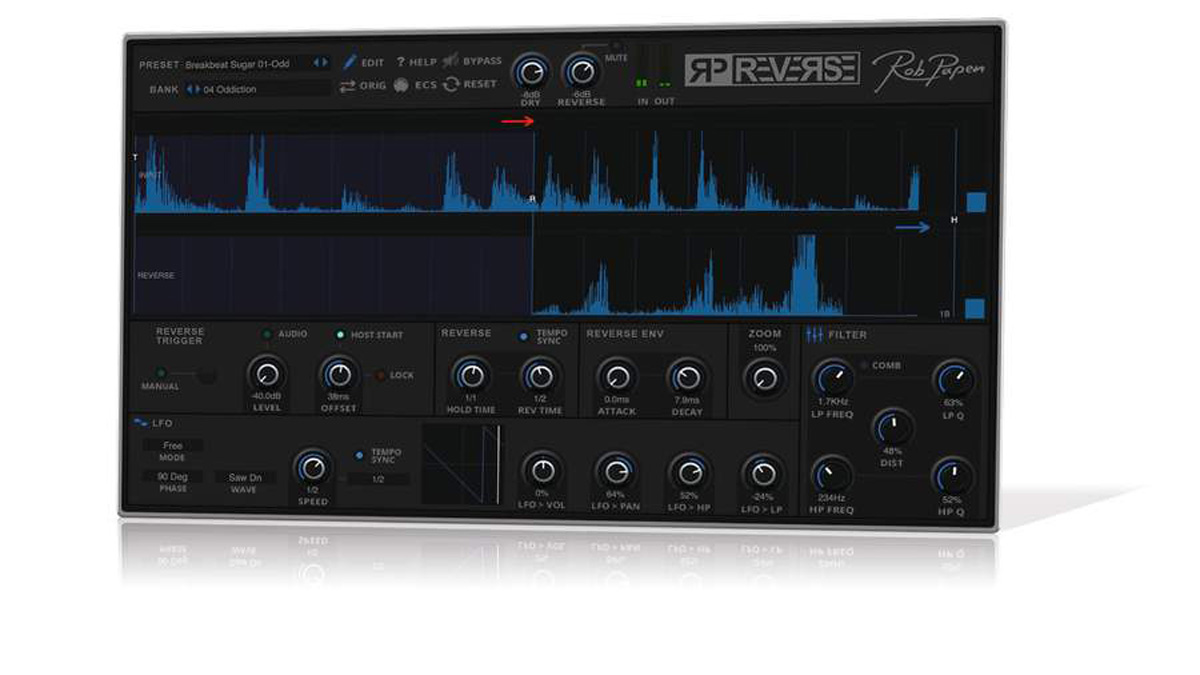MusicRadar Verdict
It might not be for everyone, but RP-Reverse is a well-designed tool for backwards FX and rhythm design
Pros
- +
A clever and novel idea.
- +
Well thought-out visualisation.
- +
Filters and LFO for sound design.
- +
Great for vocal spot FX.
Cons
- -
No easy way to instantly flip between forward and reversed signals.
- -
Inevitably unintuitive.
MusicRadar's got your back
The latest in Rob Papen’s ongoing line of affordable plugin effects is a unique buffering-and-backwards-playback effect.
RP-Reverse’s (VST/AU/AAX) workflow and functionality are a bit tricky to get a handle on at first, but in simple terms, the incoming audio is recorded into a buffer, then played back in reverse on a parallel channel. There are three ways to initiate recording: Manual has you clicking or automating a button for total ‘one-shot’ control of what gets reversed and when it subsequently plays back; the Audio option waits til the input signal level crosses a specified dB threshold; and Host simply starts recording with host playback, retriggering periodically.
The Reverse Time control governs the length of the record buffer - ie, the time it takes for reversed playback to start, and the length of the reversed section - and can be either synced to host tempo or set in seconds and milliseconds, up to 60s. Once recording is started, the Hold knob (also synced or not) sets a gap between subsequent retriggers in Audio and Host modes. So, with Reverse Time at 1/1 and Hold at 4/1, for example, you’ll get one bar of dry signal, which is recorded into the buffer, then one bar of dry signal and reversed signal in parallel, then two bars of dry signal, before that loop starts again.
The Reverse section is RP-Reverse’s main event, of course, but the plugin also makes a pretty decent showing in terms of sound-shaping features.
A pair of resonant 12dB/octave filters - Low Pass and High Pass - are preceded by a fierce distortion stage for overdrive. The Low Pass can be switched to Comb Filter mode, bringing a touch of spectacle to proceedings.
Modulation comes in a single LFO that can run free or be triggered by the reverse section, synced to host or set manually up to 3.5Hz, and angled to four phase positions (0, 90, 180 and 270o). Sine, saw (up/down), square and triangle waveforms are joined by sample-and-hold, and four target parameters are simultaneously addressed via bipolar depth knobs: Reverse signal Volume and Pan, and both filters. It’s a useful, concise setup, but an envelope follower, with the Dry or Reverse signal selectable as input, wouldn’t go amiss.
Yes, it’s head-spinning stuff, but the GUI does everything it can to make visual sense of the process, automatically resizing with the Hold length, and using markers to indicate the timing of all the events involved. The top waveform shows the input with a red arrow indicating recording progress, and the bottom wave shows the reversed channel with a blue arrow indicating reversed playback of the recording.
All mixed up
Beyond those fundamentals, the reversed signal can be faded in and out with the Attack and Decay controls (0.1-1023ms), while the Offset knob delays the start of recording in Audio and Host modes by up to 999ms, for tightening up the timing of reversed transients. Independent Dry and Reverse signal level controls are in place, too, with a Mute button for the Reverse. Given the two-channel nature of the effect, this is an understandable substitute for the usual dry/wet mix control, but one thing we found ourselves wanting but unable to do without automation was have the two signals alternate muting, for cutting the Reverse channel cleanly into and out of the Dry channel, which would be obviously beneficial with drum loops. All it would take is the addition of a Mute Dry button or a switch to toggle muting/unmuting between the channels.
Flip reverse it
RP-Reverse isn’t always easy to get meaningful results out of, largely thanks to the way reversed material just generally sounds – ie, not necessarily particularly comfortable on the ear. With the right source material, though - drum/percussion loops, synths, keys, guitars and vocals are all prime candidates - and suitable care taken over the settings (the filters are a very welcome inclusion), the results it delivers can be anything from funky and groove-enhancing to evocative and quite beautiful. The price is undoubtedly right, and the experimental potential for those prepared to explore its bi-directional possibilities is considerable.
Want all the hottest music and gear news, reviews, deals, features and more, direct to your inbox? Sign up here.
Computer Music magazine is the world’s best selling publication dedicated solely to making great music with your Mac or PC computer. Each issue it brings its lucky readers the best in cutting-edge tutorials, need-to-know, expert software reviews and even all the tools you actually need to make great music today, courtesy of our legendary CM Plugin Suite.

